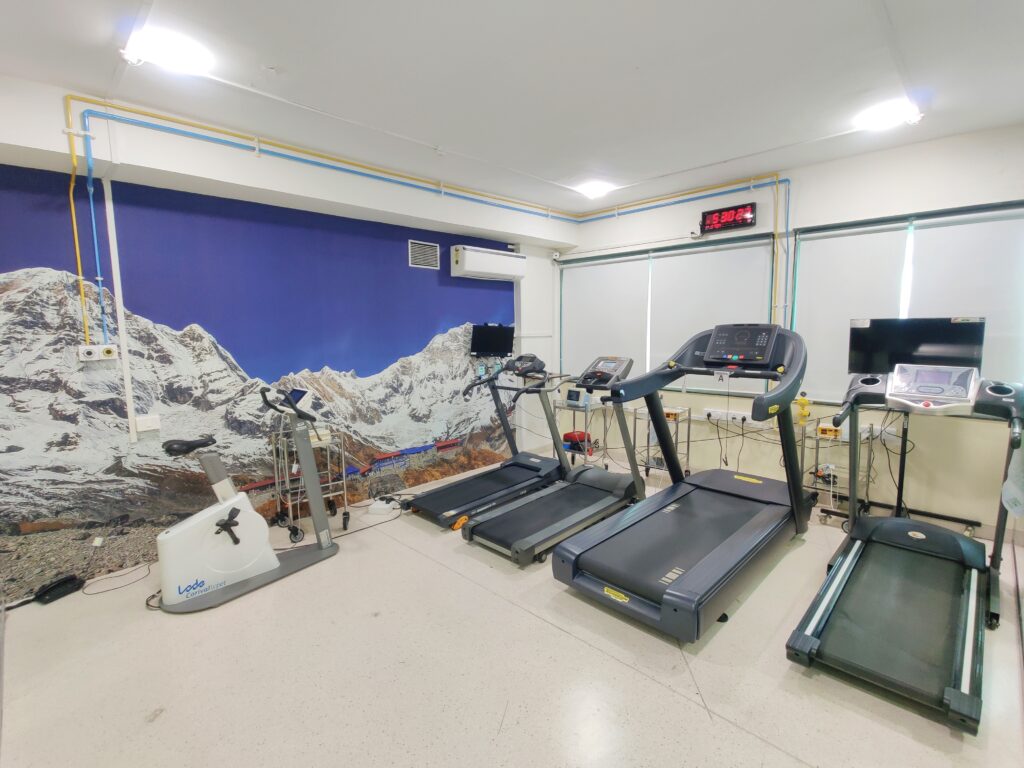Acclimatization VBS Mani Hypoxic Training Center
VBS Mani Hypoxic Training Center is one of the leading hypoxic training center in
India aimed to help people acclimatize before trek, travel, or expedition to high
altitudes.
What is acclimatization
The process of adaptation to high altitude environment is known as acclimatization.
What is pre-acclimatization?
“Exposure to the hypoxic environment for hypoxic conditioning prior to high altitude
travel is known as pre-acclimatization.”
What is the purpose of pre-acclimatization or acclimatization?
The main purposes of pre-acclimatization or acclimatization by hypoxic conditioning
(HC) of the body are the prevention of high-altitude illnesses and maintenance of
aerobic exercise performance.
How pre-acclimatization is achieved at VBS Mani Hypoxic Training Center
It is achieved through intermittent exposure to hypoxia inside a hypoxic chamber.
How hypoxia is created inside the hypoxic chamber?
Hypoxia is created by replacing oxygen with nitrogen. First nitrogen is filtered from
air and then mixed with the air entering into the hypoxic chamber.
How does hypoxia exposure occur?
The person spends some amount of time inside the chamber (either sitting, walking,
or jogging). During this period, the system is exposed to hypoxia and it stimulates the
physiology to activate certain mechanisms as a response to hypoxia. These
mechanisms achieve adaptation to hypoxia.
Is it a hypobaric chamber
No, it is not a hypobaric (less pressure) chamber since the air pressure inside the
chamber is the same as that outside the chamber. As the oxygen is only replaced by
nitrogen, the total pressure of air remains the same.
How many days prior to the high-altitude trek should one start with pre-
acclimatization?
Minimum a month before.
How to prepare for consultation at BILD Exercise Clinic for a pre-
acclimatization-related program?
Bring your medical reports.
Bring your prescription for medicines (if any).
What to expect from the doctor?
Our doctor will understand your detailed medical history.
Previous medical reports (if any) will be examined.
A record of previous high-altitude journeys will be noted.
A record of your current medications (if any) will be noted.
A record of your current exercise regime will be noted.
What investigations are needed to be done prior to starting the pre-
acclimatization program?
● No specific blood tests/investigations are needed prior to intermittent hypoxia
training.
● A detailed record of prior medical history is absolutely essential before our
doctor decides to enroll you on intermittent hypoxic training.
● We may test you for a Cardio-respiratory optimal (COP) test to know the
condition of your cardio-respiratory system.
● The doctor might ask for a routine hemogram to know certain parameters in
your blood.
● Our doctor will take a final call about your enrolment into the program.
How to prepare for hypoxic training sessions for pre-acclimatization?
● Eat light (don’t remain hungry for the session and don’t eat too heavy).
● Bring a napkin, some sweet snacks, a water bottle, gym clothes such as a T-
shirt track pants, and indoor shoes.
● Changing rooms, toilets, and drinking water facilities are available near the
hypoxic chamber.
● Ideally, bring your mobile phones charged fully. You can watch your mobile
phones or use them to keep time.
● Talking to other participants or talking on the mobile phone is NOT allowed.
This affects your breathing, blood pressure, and heart rate.
What happens during hypoxic training sessions for pre-acclimatization?
● We follow intermittent hypoxic training (IHT).
● It involves periodic exposure to hypoxia (inside the hypoxic chamber) and
normoxia (outside the hypoxic chamber).
● Our doctor will explain the protocol.
● The duration of each phase and the number of cycles are decided by the
doctor.
● Usually, 2-3 sessions a week are needed for a minimum of four weeks.
● Each session can go up to 1.5 to 2 hours.
● You will be either using a cycle, treadmill or just sitting inside the chamber
depending upon your SpO2 levels and the protocol.
● Your SpO2 levels will be monitored continuously while inside and outside the
hypoxic chamber.
How to reach BILD Exercise Clinic OPD at Deenanath Mangeshkar Hospital?
- Reach the Super Speciality Building (SS building/new building) lobby/main entrance before time. Wheelchairs are available in the lobby and parking for needy patients. Click here for the Google map location of BILD Exercise Clinic.
- Parking is available based on availability. You can prefer public transport such as bus, auto-rickshaw, cab or taxi.
- If you are not registered as a patient and appearing for the first time as a patient at Deenanath Mangeshkar Hospital then try to come at least 15 minutes before the appointment time to complete the simple registration process at the ground floor reception of the super specialty building.
- Get an OPD entry pass (for patients) and an attendant pass at the ground-floor reception.
- Choose appropriate lifts (life no.1,2,3 ) at the ground floor to reach BILD Exercise Clinic OPD on the 11th floor.
- Depending upon patient numbers some waiting period is expected. Comfortable sitting, clean drinking water, a book reading section, clean toilets, changing rooms, and a cafeteria (on the ground floor and seventh floor) are available at your service.
Book your appointment. Send WhatsApp message, SMS or give a call at 8149387706. Landline number- 020-49154101 / 4122

